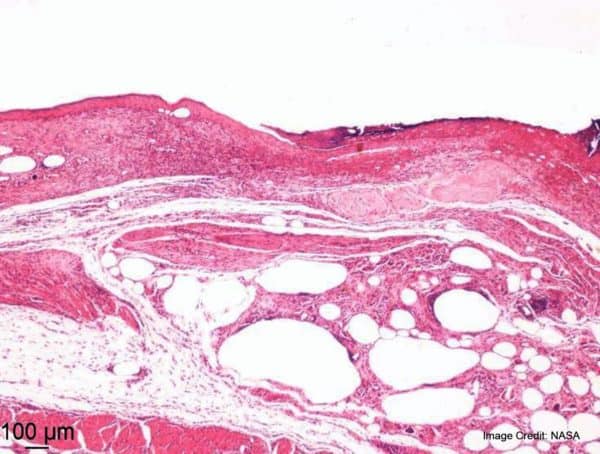
 A NASA developed bandage is a new type of bandage for helping wounds heal faster. It generates minute amounts of electricity in order to speed up the healing process. The new invention uses a polymer called polyvinylidene fluoride (PVDF) woven into a gauze-like pattern to produce a weak electric current when put in contact with skin.
A NASA developed bandage is a new type of bandage for helping wounds heal faster. It generates minute amounts of electricity in order to speed up the healing process. The new invention uses a polymer called polyvinylidene fluoride (PVDF) woven into a gauze-like pattern to produce a weak electric current when put in contact with skin.
“This method utilizes generated low level electrical stimulation to promote the wound healing process while simultaneously protecting it from infection,” says NASA in a statement. NASA projects that the new product will have applications for military personnel wounded in the field, post-surgery healing, patients with serious wounds and, notably, for astronauts in outer space.
Earth’s atmosphere makes for quite the comfy confines in comparison to the cold depths of outer space. Take away gravity and all the systems of the human body can be adversely affected, creating a range of maladies from space sickness and vision problems to fluid build-up and muscle and bone atrophy. Cuts and bruises are also a problem, as changes to blood and fluid circulation make it so that wounds heal more slowly in outer space.
Part of NASA’s Technology Transfer Program, the new bandage is made using a process called electrospinning, where an electric charge is used to create super-thin strands of polymer fibre only nanometres in diameter. NASA developed its own electrospinning apparatus which controls the flow – effectively, the weave – of polymer fibres and allows for the creation of the PVDF mats and gauzes. The new bandage not only aids in the healing process through the use of a small electric charge, its nanostructure acts as a scaffolding to promote cell growth, which helps to minimize infection and other complications during the healing process.
The ravages of outer space also come from exposure to high levels of radiation, including galactic cosmic rays. Normally rebuffed by the Earth’s atmosphere, cosmic rays can cause serious problems for astronauts including cancers and, according to a new study, not only short-term but also long-term brain damage.
The new study from the University of California Irvine investigates the phenomenon known as “space brain”, said to be a risk for astronauts on long-term space flights (such as those planned for upcoming flights to Mars) due to constant bombardment by radiation. Researchers subjected rodents to charged particle irradiation and found that six months after exposure, significant levels of brain inflammation persisted, along with damage to the dendrites and spines of brain cells.
Research found symptoms in the rodents such as poorer performance on learning and memory tests as well as potential psychological manifestations such as alteration of the psychological mechanism known as fear extinction, which helps to suppress prior unpleasant and stressful associations. A deficit in fear extinction can lead to greater anxiety, according to Charles Limoli, professor of radiation oncology at UCI’s School of Medicine.
Limoli says the study’s overall results are a significant warning sign concerning long-term space travel.”This is not positive news for astronauts deployed on a two-to-three-year round trip to Mars,” said the professor of radiation oncology in UCI’s School of Medicine. “The space environment poses unique hazards to astronauts. Exposure to these particles can lead to a range of potential central nervous system complications that can occur during and persist long after actual space travel.”
NASA researchers are currently investigating the many elements involved in a potential human flight to Mars and are subjecting NASA team members to the most severe conditions on Earth in preparation. A new documentary called “Passage to Mars” chronicles NASA’s travails across Canada’s Arctic as astronauts attempt to take the HMP Okarian, a concept rover being tested as a potential Mars vehicle, across the Northwest Passage to the HMP Research Station on Devon Island in Baffin Bay.
Comment
One thought on “This NASA developed bandage heals wounds faster with electricity”
Leave a Reply
You must be logged in to post a comment.



 Share
Share Tweet
Tweet Share
Share




“the ravages of outer space also come from exposure to high levels of radiation, including galactic cosmic rays. Normally rebuffed by the Earth’s atmosphere”,
I believe it is not the atmosphere guys, it is the magnetic field around our planet that mostly protects us from cosmic radiation, yes there is some “leakage” through the magnetic field that surrounds us ( shows up as the Northern Lights) , but the atmosphere? Not so much Correct me if I am wrong..